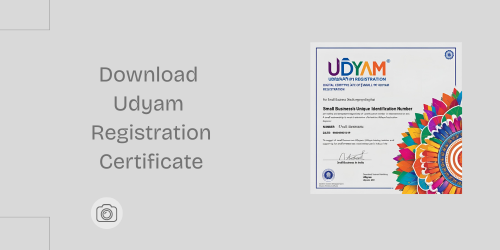In 2020, the Indian government introduced the Udyam Registration portal as a replacement for the previous system known as Udyog Aadhaar. This move aimed to simplify the registration process for micro, small, and medium enterprises (MSMEs) in India. The term “Udyam” signifies an enterprise, and “Udyam Registration” essentially refers to the process of registering a business entity as an MSME under the new system. Udyam Registration allows MSMEs to obtain a unique identification number called Udyam Registration Number (URN) online, thereby simplifying the process and eliminating the need for any paperwork. This initiative aims to promote ease of doing business, enhance competitiveness, and facilitate access to various government schemes and benefits for MSMEs in India. The transition from Udyog Aadhaar to Udyam Registration brought about several changes, including the classification criteria based on investment in plant and machinery or equipment and annual turnover, and the introduction of a new registration process through the Udyam Registration portal. Additionally, the registration under Udyam is dynamic and requires periodic updating of information to maintain validity. Update Udyog Aadhaar Registration Certificate To re-register under Udyam, you need to follow these steps: Make sure to comply with any specific guidelines or requirements outlined by the Udyam registration authority during the re-registration process. Why Do You Need To Update Udyog Aadhar ? Udyog Aadhaar is a registration process for micro, small, and medium enterprises (MSMEs) in India. It’s important to update your Udyog Aadhaar registration for several reasons: Overall, updating your Udyog Aadhaar registration is vital for ensuring compliance, accessing benefits, maintaining transparency, and facilitating the growth of your MSME. 04/05/2024 Udyam registration for proprietorship firm online Micro, Small, and Medium Enterprises (MSMEs) play a crucial role in the Indian economy for several reasons: Udyam registration Udyam Registration is a process introduced by the Government of India to facilitate the registration of micro, small, and medium-sized enterprises (MSMEs). It replaced the earlier system of registration known as the Udyog Aadhaar Memorandum (UAM). Under this system, MSMEs can register themselves online with the Ministry of Micro, Small and Medium Enterprises (MSME). The registration process is aimed at simplifying the registration procedure and providing various benefits and support to MSMEs, including easier access to credit, subsidies, schemes, and other government initiatives. MSMEs can register for Udyam online through the official portal using their Aadhaar number, PAN (Permanent Account Number), and other relevant details. Udyam Registration requires self-declaration of information related to the enterprise’s turnover, investment in plant and machinery or equipment, and other details. Once registered, MSMEs receive a unique Udyam Registration Number and an e-certificate, which serves as proof of their registration. This process helps in formalising and recognizing the contribution of MSMEs to the Indian economy and enables them to avail of various benefits and schemes offered by the government. Udyam Registration for Proprietorship Firm Udyam Registration is a government registration process in India for micro, small, and medium enterprises (MSMEs). If you’re operating a proprietorship firm and want to register under Udyam, you can follow these steps: Advantages Of MSME Registration There are several advantages to registering your business under the Micro, Small, and Medium Enterprises (MSME) sector in India. Here are some key benefits: 1.Access to Government Schemes and Subsidies: MSME registered businesses are eligible to avail various government schemes, subsidies, and incentives aimed at promoting the growth and development of small enterprises. These schemes often include financial assistance, subsidies on loans, and support for technology upgradation. 2.Priority Lending from Banks: MSME registration enables businesses to access credit facilities with lower interest rates. Banks are mandated to provide a certain percentage of their lending to MSMEs, and registered MSMEs typically receive priority in lending decisions. 3.Collateral-Free Loans: Many financial institutions offer collateral-free loans to MSMEs, making it easier for small businesses to access funding without having to provide significant assets as security. 4.Preference in Government Tenders: MSME registered enterprises often receive preference in government procurement tenders. Government agencies may reserve a certain percentage of their procurement budget for MSMEs, providing them with opportunities to secure contracts and grow their businesses. 5.Tax Benefits: MSME registration entitles businesses to various tax benefits and exemptions under government schemes. These benefits can include income tax exemptions, reduced tax rates, and concessions on indirect taxes such as GST. 6.Ease of Obtaining Licences and Permits: MSME registered businesses may find it easier to obtain licences, permits, and approvals from regulatory authorities. Governments often streamline the application process for MSMEs to promote entrepreneurship and economic growth. 7.Access to Market Development Assistance: MSME registered businesses may receive support for market development activities such as participation in trade fairs, exhibitions, and export promotion initiatives. This assistance helps small businesses expand their market reach and explore new opportunities. 8.Technology Upgradation Support: MSMEs can benefit from government schemes aimed at supporting technology upgradation and innovation. Financial assistance and subsidies are often provided to MSMEs to adopt modern technologies and improve their productivity and competitiveness.










